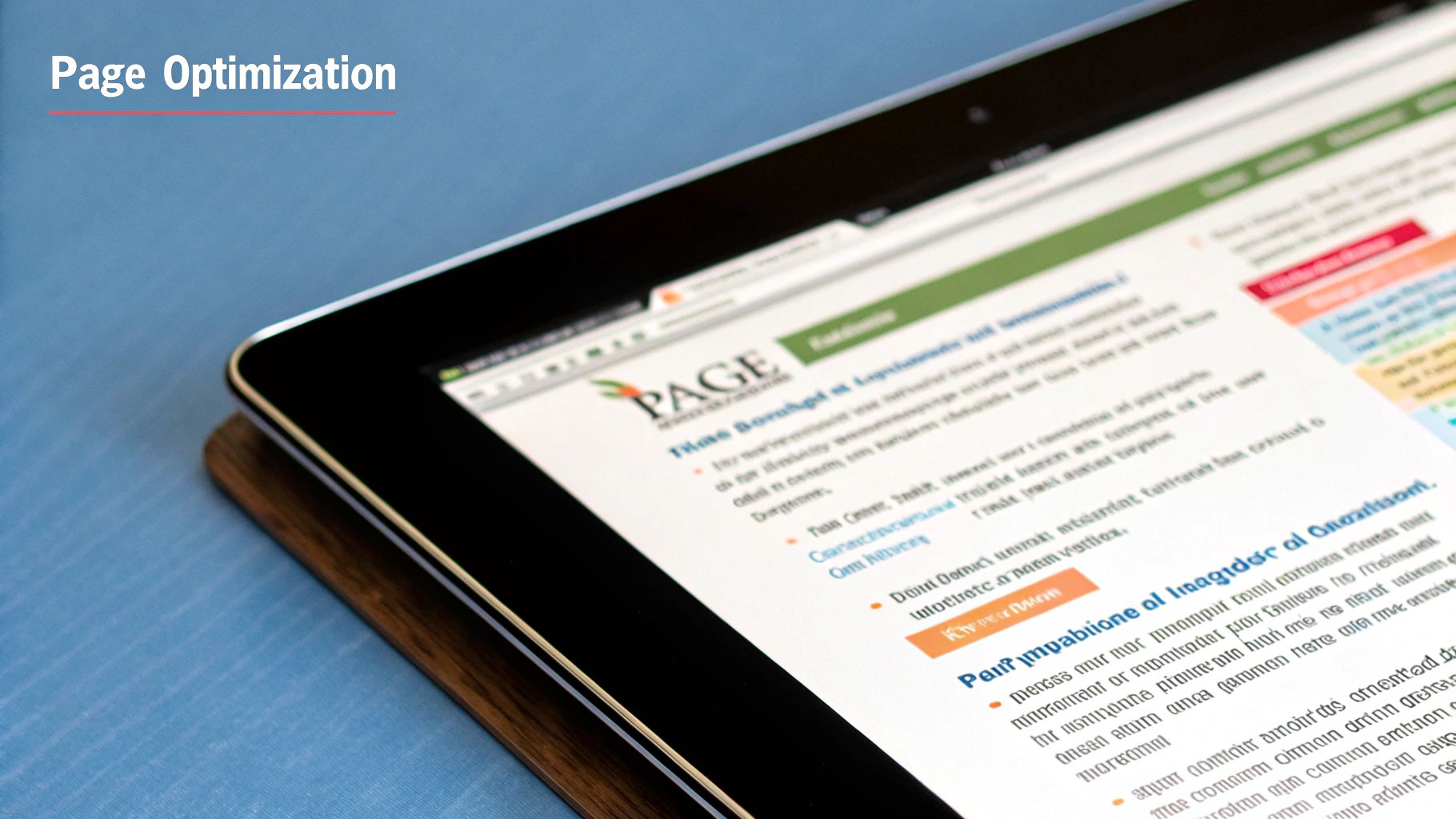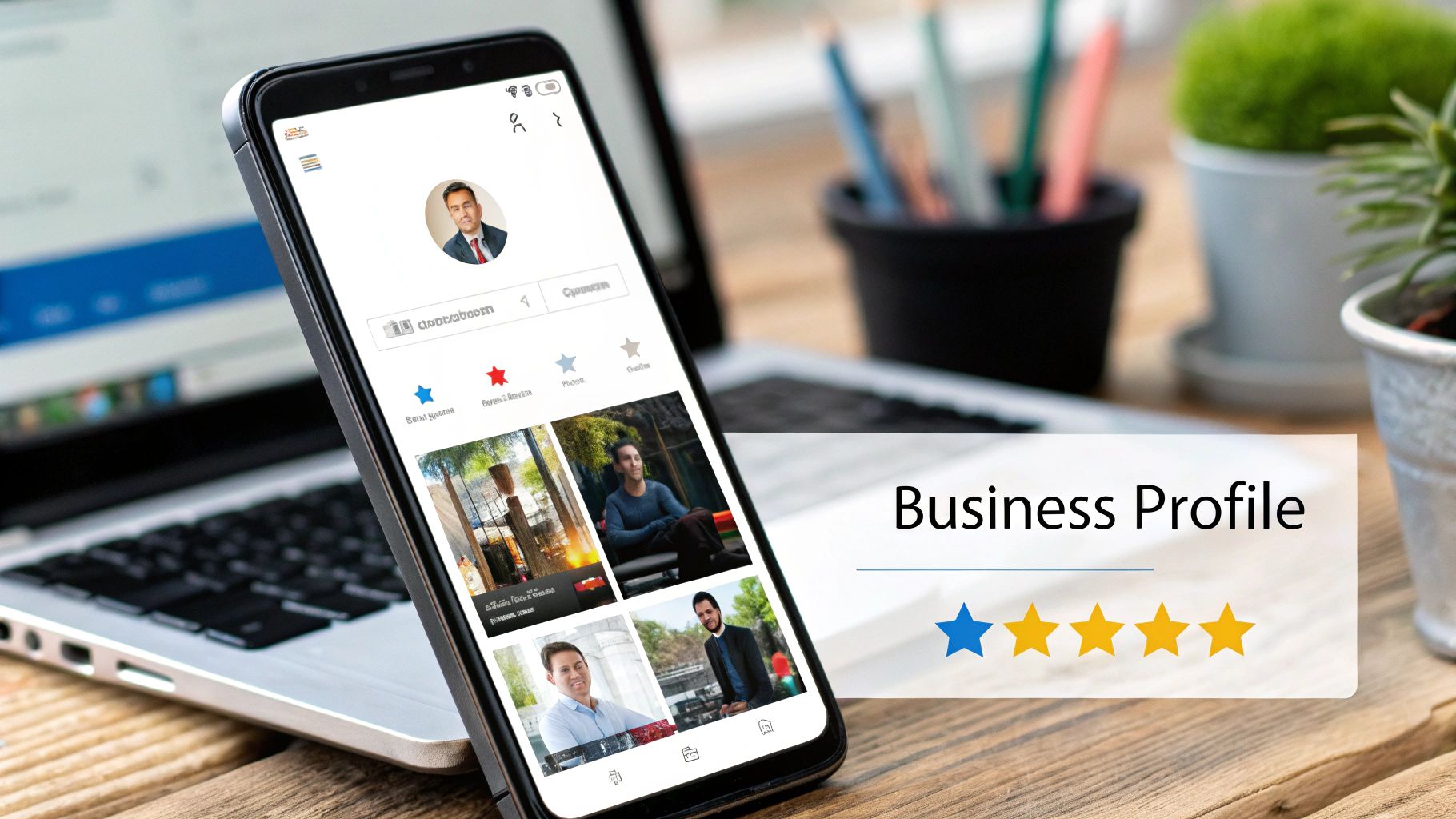In a crowded digital marketplace, simply having a website isn't enough. For small businesses, visibility in search results is the key to attracting local customers, building brand authority, and driving sustainable growth. But where do you start? The world of Search Engine Optimization (SEO) can seem complex and overwhelming, but mastering a few core strategies can make all the difference. This guide is designed to cut through the noise and deliver the best small business SEO tactics you need.
We will break down the 7 most effective and actionable strategies that form a powerful, modern SEO foundation. We'll move beyond generic advice and dive into practical steps, real-world examples, and expert tips you can implement today to start climbing the search rankings and connect with the customers who need you most. These elements are crucial for building a solid online presence. For a deeper dive into crafting your overall SEO blueprint, consider exploring this comprehensive SEO strategy guide to complement the specific tactics we'll cover here.
Whether you're a local shop, a service-based business, or an online startup, this list provides a clear roadmap to a stronger digital footprint and tangible business results. Let's explore the essential components of an SEO plan that gets you found.
1. Local SEO Optimization
For small businesses with physical locations or service areas, Local SEO isn't just a strategy; it's the most critical component of a successful digital marketing plan. This practice focuses on optimizing your online presence to attract customers searching for products or services in your specific geographical area. Unlike general SEO, which targets a global audience, Local SEO helps you appear prominently in location-specific search results, such as Google’s “local pack” and Google Maps. This is a fundamental part of the best small business seo because it allows you to compete directly with larger, national brands by winning the customers right in your neighborhood.
Consider a local bakery. Through effective Local SEO, they can rank at the top when a potential customer searches for "croissants near me." Similarly, a plumbing service can appear in the local pack for a query like "emergency plumber in Denver," driving immediate, high-intent leads. These hyper-relevant connections are what make Local SEO so powerful.
How to Implement Local SEO
To get started, focus on these foundational and highly actionable steps:
- Claim and Optimize Your Google Business Profile (GBP): This is your most important local SEO tool. Fill out every section completely, including services, products, business hours, photos, and a detailed description. Encourage customers to post questions and answer them promptly.
- Ensure NAP Consistency: Your business Name, Address, and Phone number (NAP) must be identical across your website, GBP, and all online directories (like Yelp, Yellow Pages, etc.). Inconsistencies can confuse search engines and harm your rankings.
- Generate Positive Reviews: Actively encourage satisfied customers to leave reviews on your GBP and other relevant platforms. Positive reviews build trust and are a significant ranking factor for the local pack.
- Create Location-Specific Content: If you serve multiple areas, create dedicated landing pages for each city or neighborhood. For example, a roofer serving Dallas and Fort Worth should have separate pages optimized for "roofing services in Dallas" and "roof repair Fort Worth."
Key Insight: Local SEO is about demonstrating relevance and prominence within a specific geographic area. Google's goal is to provide the best, most trustworthy local result, and your job is to prove that's your business.
For immediate and tangible results, delve into practical strategies on how to improve local SEO rankings fast. Mastering these techniques can provide a significant competitive advantage, driving more foot traffic and phone calls directly to your business.
2. Content Marketing & Blogging
For a small business, content marketing isn't just about writing articles; it's about becoming a trusted authority in your niche. This strategic approach involves creating and distributing valuable, relevant, and consistent content to attract and retain a clearly defined audience. By regularly publishing blog posts, guides, and resources that address customer pain points, you naturally incorporate target keywords, which is a core component of the best small business seo. This strategy moves beyond direct sales pitches to build long-term relationships and organic search visibility.
Imagine a local HVAC company publishing a seasonal guide on "how to prepare your AC for summer." This post can rank for valuable keywords, attract local homeowners, and position the company as a helpful expert, making them the first call for service. Similarly, a small accounting firm that creates blog posts explaining new tax laws can generate hundreds of high-quality leads from business owners seeking guidance. This is content marketing in action: solving problems to attract customers.
How to Implement Content Marketing & Blogging
To build a content engine that drives traffic and leads, focus on these essential steps:
- Research Customer Questions: Use tools like AnswerThePublic or Google’s "People Also Ask" section to discover the exact questions your target audience is searching for. Build your content calendar around these topics.
- Maintain a Consistent Schedule: Whether it's one blog post a week or two per month, consistency is key. A regular publishing schedule signals to search engines that your website is active and a reliable source of fresh information.
- Optimize Every Post: Focus each article on one primary keyword and a few related secondary keywords. Include the primary keyword in your title, URL, meta description, and naturally throughout the content.
- Include Clear Calls-to-Action (CTAs): Every piece of content should guide the reader on what to do next. This could be signing up for a newsletter, downloading a free guide, or contacting you for a quote.
Key Insight: Great SEO content doesn't just target keywords; it targets user intent. By answering the questions your potential customers are asking, you build trust and earn higher rankings simultaneously.
To maximize the impact of your content, it’s crucial to promote it effectively. For further strategies on nurturing the audience you attract, you can learn more about leveraging email marketing for your content. Integrating these strategies ensures your valuable content reaches the right people and converts them into loyal customers.
3. On-Page SEO Optimization
While Local SEO targets customers in your immediate vicinity, On-Page SEO focuses on optimizing the individual pages of your website to earn higher rankings and more relevant traffic from search engines. This practice involves fine-tuning both the visible content and the underlying HTML source code of your pages. Think of it as setting a strong foundation; without it, your other marketing efforts won't be as effective. Mastering On-Page SEO is a core pillar of the best small business seo because it gives you direct control over how search engines interpret and rank your content.
For example, a small e-commerce business selling handmade jewelry can optimize its product pages for specific terms like "silver minimalist necklace." By refining title tags, meta descriptions, and image alt text, they can attract highly qualified buyers directly from search results. Similarly, a local law firm can improve its click-through rate by crafting compelling meta descriptions that clearly state its expertise, such as "Family Law Attorney in Austin – Free Consultation." These targeted optimizations lead to more qualified traffic and better conversion rates.
How to Implement On-Page SEO
To start optimizing your website's pages, concentrate on these essential and impactful techniques:
- Optimize Title Tags and Meta Descriptions: Your title tag is a primary ranking factor and should include your target keyword. Write a compelling meta description (under 160 characters) that acts as an ad for your page, encouraging users to click.
- Use Header Tags Logically: Structure your content with header tags (H1, H2, H3). Your main title should be the H1, with subheadings used to break up content and improve readability for both users and search engines.
- Optimize Images: Use descriptive file names and add alt text to every image. Alt text helps search engines understand the image content and improves accessibility for visually impaired users.
- Create SEO-Friendly URLs: Keep your URLs short, descriptive, and include your primary keyword. For example,
yourwebsite.com/services/emergency-plumbingis much better thanyourwebsite.com/p?123.
Key Insight: On-Page SEO is about making your content as clear and valuable as possible for both search engines and human visitors. Every element on the page is an opportunity to signal relevance and authority.
To build a comprehensive strategy, you can explore more advanced techniques and concepts. For a deeper look into how these elements fit together, you can find a wealth of information in this digital strategy guide.
4. Google My Business Optimization
While closely related to Local SEO, fully optimizing your Google Business Profile (formerly Google My Business) is a standalone strategy so powerful it deserves its own spot. This free tool is essentially your business's digital storefront on Google Search and Maps. It’s often the first interaction a potential customer has with your brand, making it a cornerstone of the best small business seo for any company targeting a local audience. By managing it effectively, you can directly influence how customers perceive you and whether they choose you over a competitor.
Think of a local restaurant that increases its online reservations by 60% after consistently using Google Posts to share daily specials and events. Or consider an auto repair shop that climbs from the eighth position to the second spot in local search results simply by completing its profile and actively encouraging reviews. These aren't just hypotheticals; they are the direct results of a dedicated GBP strategy.
How to Implement Google Business Profile Optimization
To transform your profile into a customer-generating machine, concentrate on these high-impact actions:
- Complete Your Profile to 100%: Don't skip any sections. Fill out your services, products, accessibility options, business attributes (e.g., "woman-owned"), and a detailed, keyword-rich description. The more information you provide, the better Google can match you to relevant searches.
- Upload High-Quality Photos and Videos Regularly: Showcase your products, your team, your location, and your completed work. Fresh, high-quality media proves your business is active and gives customers a real look inside your operations.
- Use Google Posts Weekly: Share updates, promotions, events, and new products. These posts appear directly in your profile on Search and Maps, providing timely information that can drive immediate action from searchers.
- Respond to All Reviews Promptly: Engage with both positive and negative reviews in a professional manner. This shows prospective customers that you value feedback and are committed to customer service.
- Leverage the Q&A Feature: Proactively add your own frequently asked questions and answer them. This allows you to control the narrative and provide valuable information upfront, reducing friction for potential customers.
Key Insight: Your Google Business Profile is not a "set it and forget it" tool. It is a dynamic platform that rewards active and consistent engagement with higher visibility and increased customer interaction.
For those looking to dive deeper into the nuances of this platform, industry experts like Joy Hawkins at Sterling Sky offer invaluable resources and advanced tactics. Mastering your GBP is one of the most cost-effective ways to improve your local search presence and drive tangible business growth.
5. Link Building and Local Citations
For a small business, authority is built through trust and reputation, both in the real world and online. Link building and local citations are the digital equivalents of word-of-mouth referrals and business directory listings. This dual strategy involves earning high-quality backlinks from other reputable websites while simultaneously ensuring your business information is accurately listed across relevant online directories. This is a core tenet of the best small business seo because it signals to search engines that your business is legitimate, prominent, and a trusted authority in your niche and local area.
Backlinks act as "votes of confidence" from other sites, directly impacting your domain authority and search rankings. Citations, which are mentions of your business Name, Address, and Phone number (NAP), reinforce your geographic relevance and help you rank in local search results. Together, they create a powerful combination that enhances both your general and local SEO performance.
How to Implement Link Building and Local Citations
To build authority effectively, focus on a targeted and consistent approach:
- Focus on Quality, Not Quantity: One high-quality backlink from a respected local news site or industry blog is far more valuable than dozens of low-quality links from spammy directories. Seek out relevant, authoritative sources.
- Start with Local Directories: Begin by ensuring your business is listed correctly on foundational platforms like Yelp, Yellow Pages, and industry-specific sites (e.g., TripAdvisor for restaurants, Avvo for lawyers). A consistent NAP is crucial.
- Build Local Relationships: Sponsor a local charity event, join the Chamber of Commerce, or partner with a complementary non-competing business. These real-world relationships often lead to valuable, natural backlinks from their websites.
- Create "Linkable Assets": Develop content that others will want to link to. This could be a comprehensive guide on a local topic, a helpful calculator, or an original data study relevant to your industry. Promote this asset to local bloggers, journalists, and organizations.
Key Insight: Link building for small businesses isn't about complex, large-scale campaigns. It's about embedding your business into the local digital ecosystem through community engagement, valuable content, and consistent directory listings.
6. Technical SEO and Site Performance
Technical SEO is the foundation upon which all your other marketing efforts are built. It involves optimizing your website's infrastructure to ensure search engines can effectively crawl, index, and understand your content. For small businesses, this isn't just about appeasing Google; it's about providing a fast, secure, and seamless user experience. A technically sound website is a core component of the best small business seo because it directly impacts both rankings and user satisfaction, which in turn influences conversions.
Think of it like building a house. You wouldn't paint the walls or add furniture before ensuring the foundation and framework are solid. A local service business that improves its page load speed can see a significant drop in bounce rates, while an e-commerce store that fixes its site architecture can help customers find products faster, directly boosting sales and search visibility.
How to Implement Technical SEO
To get started, focus on these critical and highly impactful technical optimizations:
- Audit Your Site Speed: Use free tools like Google PageSpeed Insights to analyze your site's performance. It will provide a detailed report on what’s slowing you down, such as large images or inefficient code.
- Prioritize Mobile-First Design: With the majority of searches happening on mobile devices, your website must be fully responsive. This means it should look and function perfectly on any screen size, from a desktop monitor to a smartphone.
- Secure Your Website with SSL: An SSL certificate (which gives you "https://") encrypts data between your site and its visitors. It's a sign of trust for users and a confirmed, albeit small, ranking factor for Google.
- Create and Submit an XML Sitemap: An XML sitemap is a file that lists all the important pages on your website, making it easier for search engines to discover and index your content.
- Fix Broken Links: Regularly audit your site for broken links (404 errors) and fix them. Too many broken links create a poor user experience and can hinder search engine crawlers.
Key Insight: Technical SEO ensures there are no roadblocks preventing search engines from accessing your content or users from enjoying your site. It’s the invisible but essential work that makes all your content and local SEO efforts truly effective.
For those just starting, building a technically sound website from the ground up is crucial. Understanding the basics can save you from costly fixes down the line. To get it right from the start, you can learn more about how to build a website with a solid foundation on sugarpixels.com.
7. Review Management and Reputation SEO
In today's digital marketplace, your online reputation is inseparable from your search ranking. Review Management and Reputation SEO is the strategic process of generating, monitoring, and responding to online reviews to build trust and improve visibility. Search engines like Google view a steady stream of positive reviews as a powerful signal of a business's authority and relevance. This practice is a cornerstone of the best small business seo because modern consumers rely heavily on peer feedback before making purchasing decisions, and search algorithms have evolved to reflect this behavior.
Think of a local dental practice. By systematically encouraging happy patients to leave feedback, they can significantly increase their bookings. Similarly, a home services company that professionally addresses a negative review, offering a public solution, can turn a potential crisis into a demonstration of excellent customer service, winning over future clients who see their commitment. These actions directly influence both customer perception and local search rankings.
How to Implement Review Management
To build a stellar online reputation that boosts your SEO, focus on these proactive steps:
- Systematize Review Requests: Don't leave reviews to chance. Implement a simple process to ask satisfied customers for feedback via email, SMS, or a simple handout after a service. Timing is key; ask when their positive experience is still fresh.
- Respond to All Reviews: Engage with every review, both positive and negative. Thank customers for positive feedback and address negative comments professionally and constructively. A thoughtful response shows you value customer feedback and are committed to quality service.
- Monitor Multiple Platforms: Your reputation exists across the web. Regularly monitor reviews on your Google Business Profile, Yelp, Facebook, and any industry-specific sites. Use tools to consolidate these mentions into a single dashboard.
- Leverage Reviews on Your Website: Showcase your best testimonials and reviews directly on your website. Implementing review schema markup can help display star ratings directly in search results, increasing click-through rates.
Key Insight: Reputation SEO is not just about damage control; it's about proactively building a digital portfolio of trust. Every positive review is a vote of confidence that both customers and search engines recognize and reward.
For businesses looking to master this, experts like Joy Hawkins at Sterling Sky provide invaluable insights into how reviews directly impact local search performance. Integrating a robust review strategy is a non-negotiable for long-term success.
7 Key SEO Strategies Comparison
| Strategy | Implementation Complexity 🔄 | Resource Requirements ⚡ | Expected Outcomes 📊 | Ideal Use Cases 💡 | Key Advantages ⭐ |
|---|---|---|---|---|---|
| Local SEO Optimization | Medium 🔄 – Requires ongoing monitoring | Moderate ⚡ – Tools plus local citation efforts | High local conversion rates 📊 | Small businesses targeting local customers | Cost-effective, builds trust & mobile-friendly ⭐ |
| Content Marketing & Blogging | High 🔄 – Consistent content creation & planning | High ⚡ – Time and creative resources needed | Long-term authority and organic traffic 📊 | Businesses focusing on education & branding | Builds authority, attracts backlinks ⭐ |
| On-Page SEO Optimization | Medium 🔄 – Technical skills needed | Moderate ⚡ – SEO tools and website access | Improved rankings and user experience 📊 | Websites needing content and HTML optimization | Quick impact, cost-effective ⭐ |
| Google My Business Optimization | Low-Medium 🔄 – Profile setup and regular updates | Low ⚡ – Time for management and updates | Increased local visibility and customer actions 📊 | Local businesses aiming for local search prominence | Free to use, direct local impact ⭐ |
| Link Building & Local Citations | High 🔄 – Time-intensive and ongoing process | High ⚡ – Outreach and monitoring tools | Improved domain authority and referral traffic 📊 | Businesses seeking authority and local SEO | Long-term SEO benefits, builds relationships ⭐ |
| Technical SEO & Site Performance | High 🔄 – Requires technical expertise | High ⚡ – Developer support and tools | Better UX, higher rankings, lower bounce 📊 | Sites needing improved infrastructure | Direct ranking factor, improves UX ⭐ |
| Review Management & Reputation SEO | Medium-High 🔄 – Constant monitoring & response | Moderate ⚡ – Time and platform monitoring | Higher local rankings, increased trust 📊 | Businesses reliant on customer reviews | Builds credibility, directly impacts local SEO ⭐ |
Putting It All Together: Your Path to SEO Success
The journey to the top of search engine results is a marathon, not a sprint. This guide has detailed the essential pillars that form the foundation of the best small business SEO strategy, from dominating your local market to building an unshakeable digital reputation. We've explored the immense power of local SEO, the authority-building potential of content marketing, and the absolute necessity of a technically sound website. Each strategy, whether it's optimizing your Google Business Profile or actively managing customer reviews, is a critical piece of a much larger puzzle.
While the scope of SEO can feel overwhelming, the key is to view it not as a list of one-off tasks but as an integrated, ongoing process. Your efforts in one area will naturally amplify your results in another. For instance, creating high-quality blog content (Content Marketing) strengthens your On-Page SEO, attracts backlinks (Link Building), and provides valuable updates for your Google Business Profile. This interconnectedness is where the magic happens.
Your Actionable Next Steps
To transform these concepts into tangible results, focus on methodical implementation rather than trying to do everything at once. Consistency will always outperform short bursts of intense activity.
Here is a simple, actionable plan to get started:
- Conduct a Foundational Audit: Begin with the basics. Run a site speed test using Google's PageSpeed Insights to address Technical SEO. Then, meticulously review and complete every single section of your Google Business Profile. This is your low-hanging fruit.
- Prioritize On-Page Essentials: Go through your most important service pages and ensure they have optimized title tags, meta descriptions, and header tags as outlined in our On-Page SEO section. Make sure your primary keyword for each page is clearly and naturally integrated.
- Commit to Content: You don't need to publish a blog post every day. Start by committing to one or two high-value articles per month that answer your customers' most pressing questions. This consistent effort will build topical authority over time.
- Build Local Trust: Implement a simple system to request reviews from happy customers to boost your Review Management efforts. Simultaneously, start identifying local directories and partners for Local Citation and link-building opportunities.
By mastering these elements, you are not just chasing algorithms; you are building a resilient digital asset that generates leads, builds brand authority, and drives revenue for your business 24/7. Embracing the best small business SEO practices is an investment in your company's long-term visibility and profitability. Take the first step today, and begin building a search presence that your competitors can only envy.
Ready to accelerate your growth and implement a professional SEO strategy without the steep learning curve? The experts at Sugar Pixels specialize in crafting and executing comprehensive SEO campaigns tailored for small businesses just like yours. Visit Sugar Pixels to learn how our team can turn your website into a powerful, lead-generating machine.



